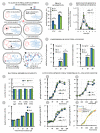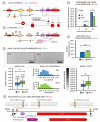Virus-Host Interaction Gets Curiouser and Curiouser. PART I: Phage P1 vir Enhanced Development in an E. coli DksA-Deficient Cell
- PMID: 34072628
- PMCID: PMC8198154
- DOI: 10.3390/ijms22115890
Virus-Host Interaction Gets Curiouser and Curiouser. PART I: Phage P1 vir Enhanced Development in an E. coli DksA-Deficient Cell
Abstract
Bacteriophage P1 is among the best described bacterial viruses used in molecular biology. Here, we report that deficiency in the host cell DksA protein, an E. coli global transcription regulator, improves P1 lytic development. Using genetic and microbiological approaches, we investigated several aspects of P1vir biology in an attempt to understand the basis of this phenomenon. We found several minor improvements in phage development in the dksA mutant host, including more efficient adsorption to bacterial cell and phage DNA replication. In addition, gene expression of the main repressor of lysogeny C1, the late promoter activator Lpa, and lysozyme are downregulated in the dksA mutant. We also found nucleotide substitutions located in the phage immunity region immI, which may be responsible for permanent virulence of phage P1vir. We suggest that downregulation of C1 may lead to a less effective repression of lysogeny maintaining genes and that P1vir may be balancing between lysis and lysogeny, although finally it is able to enter the lytic pathway only. The mentioned improvements, such as more efficient replication and more "gentle" cell lysis, while considered minor individually, together may account for the phenomenon of a more efficient P1 phage development in a DksA-deficient host.
Keywords: DksA; P1 phage; P1vir bacteriophage; host-virus interactions; lytic development.
Conflict of interest statement
The authors declare no conflict of interest.
Figures




References
-
- Lehnherr H. Bacteriophage P1. In: Calendar R., editor. The Bacteriophages. Oxford University Press; Oxford, UK: 2006. pp. 350–379.
-
- Yarmolinsky M.B., Sternberg N. Bacteriophage P1. In: Calendar R., editor. The Bacteriophages. The Viruses. Springer; Boston, MA, USA: 1988. pp. 291–438.
MeSH terms
Substances
Grants and funding
LinkOut - more resources
Full Text Sources
Miscellaneous

